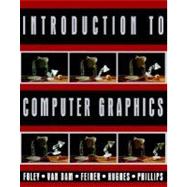Introduction to Computer Graphics

Introduction to Computer Graphics
- ISBN 13:
9780201609219
- ISBN 10:
0201609215
- Edition: 1st
- Format: Hardcover
- Copyright: 08/31/1993
- Publisher: Addison-Wesley Professional
Note: Supplemental materials are not guaranteed with Rental or Used book purchases.
Extend or Purchase Your Rental at Any Time
Need to keep your rental past your due date? At any time before your due date you can extend or purchase your rental through your account.
Summary
This book is an adaptation of Computer Graphics: Principles and Practice, Second Edition (CGPP), by Foley, van Dam, Feiner, and Hughes. Introduction to Computer Graphics was created by abridging and modifying that comprehensive teaching and reference work to suit the needs of different courses and different professional requirements. While this book is half the size of its parent, it is not merely a shorter version of it. Indeed, it features new material and, in some cases, a different approach to exposition, all added with the needs of its intended audience in mind.
This book is designed to be used in a one-to two-semester course in computer graphics in any four-year college or university and, assuming only a small amount of mathematical preparation, for a one-semester course in community colleges or other two-year institutions. Introduction to Computer Graphics is also an ideal book for the professional who wants to learn the rudiments of this dynamic and exciting field, whether to become a practitioner or simply to gain an appreciation of the far-ranging applications of computer graphics.
This book is not meant to supplant CGPP as being more current or in any way more comprehensive. These are chapters, however, where, because of the dizzying pace at which the field is moving, older material was dropped and the hardware performance and cost figures were updated. One such example can be found in Chapter 4, where the statement from CGPP--which, bear in mind, was just published in 1990--that "...a graphics workstation typically consists of a CPU capable of executing at least several million instructions per second (MIPS) ..." was updated to reflect the fact that 20-100 MIPS are now commonplace.
Other major differences and strengths of Introduction to Computer Graphics are:
Potential Syllabi
There are several paths that a reader can take through this book. A few are suggested here, but it is entirely feasible to select one suiting the reader's circumstances. Even the order of study acan be permuted. For example, the material on hardware could come either earlier or later in a syllabus than is suggested by Chapter 4's ordinal positioning.A minimal one-semester course emphasizing 2D graphics. Where the goal is to provide a good, but not rigorous, overview of elements of mostly 2D graphics, this course of study will be appropriate for students in a two- or four-year college or university.
Chapter Sections 1 All 2 Sect. 2.1-2.2 3 Sect. 3.1-3.3, 3.9-3.9.3 4 Sect. 4 4.1, 4.2, 4.3, and 4.5 5 Sect. 5.1 (as appropriate), 5.2, 5.3,5.4 6 Sect. 6.1, 6.2,6.3,6.4.1,6.4.2 8 All 9 Sect. 9.1, 9.2.1-9.2.3 11 Sect. 11.1-11.2 12 Selected reading to demonstrate advanced capabilitiesA one-semester course providing an overview of 2D and 3D graphics. This syllabus will provide a strong foundation in graphics for readers who are mathematically well prepared.Chapter Sections 1 All 2 All 3 Sects. 3.1-3.5, 3.8-3.11, 3.14-3.15 4 Sect. 4.1, 4.2, 4.3 and 4.5 5 Sect. 5.1 (as appropriate),5.2-5.5,5.7,5.8 6 Sect. 6.1-6.5, Sect. 6.6 (except 6.6.4),6.7 7 Sect. 7.1-7.5,7.10 and 7.11.6 8 All 9 Sect. 9.1,9.2.1-9.2.3,9.2.7,9.3.1-9.3.2 11 All 12 All 13 Sect. 13.1-13.2, possibly 13.4 14 Sect. 14.1-14.2, possibly 14.5-14.7A two-semester course covering 2D and 3D graphics, modeling and rendering. All chapters (posibly omitting selected topics from Chapters 9 and 10) plus selected topics from CGPP.
Since many readers of Introduction to Computer Graphics will be interested in consulting its more advanced and comprehensive parent, the preface to CGPP follows this one. Please find the this title included on the gopher site. There the reader will find a discussion of CGPP's important features and suggestions for structuring courses based on that book.
Electronic Instructor's Manual
An Electronic Instructor's Manual (EIM), which supplements this book, is available from Brown University. Information on how to obtain the EIM is acquired by sending e-mail to eim@cs.brown.edu. No message body is necessary; just enter EIM (or eim) on the Subject line. The e-mail reply will contain a description of the contents of the EIM and how to obtain any part of it. It is necessary to have Internet ftp access to retrieve the EIM. No other distribution method is available. The EIM comprises four parts. They are:
- Expanded versions of the syllabi suggested above. The rationale for each syllabus is described on a step-by-step basis. Also, where appropriate, aids to teaching the material are suggested.
- Selected ANSI C source code from the book. Program fragments as well as complete working programs are provided. In general, an instructor must have SRGP and SPHIGS for this code to be useful.
- All the artwork from the book. With the exception of stripped-in half- tones, each figure is provided as either an Encapsulated Postscript (EPS) or Tagged Image File Format (TIFF) file. These figures will be useful for preparation of lecture slides. The artwork files are organized by chapter so that an instructor can obtain just the figures needed for a particular syllabus.
- Freely available software resources. In addition to the SRGP and SPHIGS packages which supplement the text, there are many packages available that the instructor may wish to obtain for use in the course. Packages such as SIPP (Simple Polygon Processor) and Rayshade, a ray tracing program, implement many of the realistic rendering techniques described in the text. Information on how to obtain these and other pa






